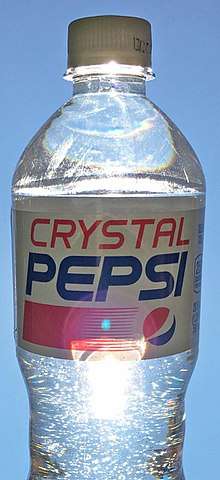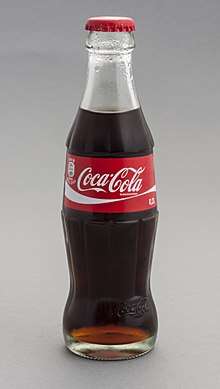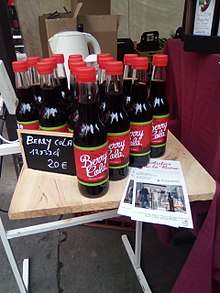Cola
 A glass of cola served with ice cubes | |
| Type | Soft drink |
|---|---|
| Manufacturer | Various |
| Country of origin | United States |
| Introduced | 1886 |
| Color | Caramel |
| Flavor | Cola (kola nut, citrus, cinnamon and vanilla) |
Cola is a sweetened, carbonated soft drink flavored with vanilla, cinnamon, citrus oils and other flavorings. Most contain caffeine, which was originally sourced from the kola nut, leading to the drink's name, though other sources are now also used. Cola became popular worldwide after pharmacist John Pemberton invented Coca-Cola in 1886.[1] His non-alcoholic recipe was inspired by the coca wine of pharmacist Angelo Mariani, created in 1863.[1]
Most modern colas usually contain caramel color, and are sweetened with sugar or high-fructose corn syrup. They now come in numerous different brands. Among them, the most popular are Coca-Cola and Pepsi. These two companies have been competing since the 1890s, but their rivalry has intensified since the 1980s.
Flavorings
The primary modern flavoring ingredients in a cola drink are citrus oils (from orange, lime, and lemon peels), cinnamon, vanilla, and an acidic flavorant.[2][3] Manufacturers of cola drinks add trace flavorings to create distinctively different tastes for each brand. Trace flavorings may include a wide variety of ingredients, such as spices like nutmeg or coriander, but the base flavorings that most people identify with a cola taste remain citrus, vanilla and cinnamon. Acidity is often provided by phosphoric acid, sometimes accompanied by citric or other isolated acids. Coca-Cola's recipe is maintained as a corporate trade secret.
A variety of different sweeteners may be added to cola, often partly dependent on local agricultural policy. High-fructose corn syrup (HFCS) is predominantly used in the United States and Canada due to the lower cost of government-subsidized corn. In Europe, however, HFCS is subject to production quotas designed to encourage the production of sugar; sugar is thus typically used to sweeten sodas.[4] In addition, stevia or an artificial sweetener may be used; "sugar-free" or "diet" colas typically contain artificial sweeteners only.
Clear cola

In the 1940s, Coca-Cola produced White Coke at the request of Marshal of the Soviet Union Georgy Zhukov.[5]
Clear colas were again produced during the Clear Craze of the early 1990s. Brands included Crystal Pepsi, Tab Clear, and 7 Up Ice Cola. Crystal Pepsi has been repeatedly reintroduced in the 2010s.
In Denmark, a popular clear cola was made by the Cooperative FDB in 1976. It was especially known for being the "Hippie Cola" because of the focus of the harmful effects the color additive could have on children and the boycott of multinational brands. It was inspired by a campaign on harmful additives in Denmark by the Environmental-Organisation NOAH, an independent Danish division of Friends of the Earth. This was followed up with a variety of sodas without artificial coloring.[6] Today many organic colas are available in Denmark, but, for nostalgic reasons, clear cola has still maintained its popularity to a certain degree.[7]
In June 2018, Coca-Cola introduced Coca-Cola Clear in Japan.[8][9]
Health effects
A 2007 study found that consumption of colas, both those with natural sweetening and those with artificial sweetening, was associated with increased risk of chronic kidney disease. The phosphoric acid used in colas was thought to be a possible cause.[10]
Studies indicate "soda and sweetened drinks are the main source of calories in [the] American diet",[11] so most nutritionists advise that Coca-Cola and other soft drinks can be harmful if consumed excessively, particularly to young children whose soft drink consumption competes with, rather than complements, a balanced diet. Studies have shown that regular soft drink users have a lower intake of calcium, magnesium, ascorbic acid, riboflavin, and vitamin A.[12]
The drink has also aroused criticism for its use of caffeine, which can cause physical dependence (caffeine addiction).[13] A link has been shown between long-term regular cola intake and osteoporosis in older women (but not men).[14] This was thought to be due to the presence of phosphoric acid, and the risk was found to be the same for caffeinated and noncaffeinated colas, as well as the same for diet and sugared colas.
Many soft drinks are sweetened mostly or entirely with high-fructose corn syrup, rather than sugar. Some nutritionists caution against consumption of corn syrup because it may aggravate obesity and type-2 diabetes more than cane sugar.[15]
Regional brands
Asia
- Amrat Cola, popular in Pakistan
- Big Cola, popular in Indonesia
- Bovonto, popular in South India
- Campa Cola was India's most popular brand prior to the introduction of Coca-Cola and Pepsi to the Indian market in 1991
- Clemon by Akij Group, popular in Bangladesh
- Cola Turka is a local brand in Turkey
- Est Cola, a local brand in Thailand
- Future Cola, a local brand in China
- Laoshan Cola, a local brand in China
- Mecca Cola, sold in the Middle East, North Africa, as well as parts of Europe
- Pakola, popular in Pakistan
- Parsi Cola, popular in Iran
- Red Bull Cola, popular in Thailand
- Thums Up, popular in India
- Topsia Cola, popular in Iran
- Zamzam Cola, popular in Iran and parts of the Arab world
Europe
- Afri-Cola, a German brand, was relaunched in April 2006 with the original formulation with the higher caffeine content.
- Barr Cola made by A.G. Barr (the makers of the popular Irn-Bru drink) in the United Kingdom
- Breizh Cola is a local brand from Brittany (France).[16]
- Brisa Cola is a local brand from Madeira, Portugal and produced by Empresa de Cervejas da Madeira.
- Cadet-Cola, an Irish brand
- Cockta is a local brand from former Yugoslavia, which does not contain any caffeine or phosphoric acid.
- Corsica Cola is a regional cola distributed by the Corsican brewery Pietra.
- Cuba Cola is a brand from Sweden.
- Evoca Cola is a cola made with mineral water made by Evoca Drinks.
- Fentimans Curiosity Cola, is an upmarket botanically brewed cola produced by Fentimans, from the UK.
- Fritz-Kola, a cola soft drink from Hamburg, Germany, uses the highest possible concentration of caffeine for beverages allowed by German law.
- Jolly Cola, which was more popular than Coca-Cola and Pepsi Cola during the 1960s and 1970s in Denmark.
- Karma Cola, fair trade cola from the UK.
- Kofola is the primary rival to Coca-Cola and Pepsi in the Czech Republic and Slovakia, and does not contain phosphoric acid.
- LOCKWOODS Cola,[17][18] a UK cola brand introduced in the 1960s produced by Lockwoods Foods Limited at their canning factory site in Long Sutton, England, the drink is not on the market anymore, it was sold nationally and also exported.
- Planet Cola, a brand sold at Auchan.
- Polo-Cockta, a Polish brand.
- Red Bull Cola has been available throughout Europe since 2008.
- Sky Cola, a Bosnian brand since 2002 made by water-bottling company Sarajevski kiseljak[19]
- Sky Cola, a Croatian brand since 2002 made by water-bottling company Jamnica
- Ubuntu Cola is a fair trade cola from the United Kingdom available in parts of Western Europe.
- Virgin Cola was popular in South Africa and Western Europe in the 1990s but has waned in availability.
- Vita-Cola is a German cola brand with a distinct citrus flavor; nowadays it is mostly sold in eastern Germany.
- XL Cola was a Swedish cola brand introduced in 1985, but the drink is not at the market anymore.
- Mole Cola is an Italian cola sold in Italy it is also occasionally sold in France in stores called Noz only.
North America

- Coca-Cola, often referred to simply as Coke, is one of the most popular cola brands in North America and worldwide.
- Pepsi, produced and manufactured by PepsiCo, is also one of the most popular cola brands in North America and worldwide. Pepsi is the main competitor of Coca-Cola.
- Cott produces many house brand beverages as well as its own line of products, most notably its Black Cherry cola.
- The Double Cola Company, Double Cola
- Faygo Cola is distributed in the Eastern United States and can be found in some regions of Canada.
- Fentimans Curiosity Cola, originating from the United Kingdom in 1905, now sold across Europe and North America
- Jarritos Cola is a brand of cola from Mexico, native to Mexico and widely distributed to Latino residents of the United States.
- Jolt Cola is sold by Wet Planet Beverages of Rochester, New York.
- Jones Soda also makes a cola using cane sugar.
- Polar Beverages of Worcester, MA produces its own brand of cola under the Polar name.
- Red Bull Cola was available in the United States from 2008-2011.
- Royal Crown Cola, also called RC Cola for short, now produced by the Dr Pepper Snapple Group
- Shasta Cola, produced by Shasta
- TuKola and Tropicola are brands from Cuba (also sold widely in Italy).
- Zevia Cola is a zero calorie soft drink sweetened with Stevia combined with Monk Fruit and Erythritol.
South America
Oceania
- LA Ice Cola is an Australian cola owned by Tru Blu Beverages, similar to Coca-Cola and Pepsi, which are its rivals.
See also
- Cola chicken
- Open-source cola – a soft drink whose recipe is publicly published
- List of brand name soft drinks products
- List of soft drink flavors
- List of soft drink producers
- List of soft drinks by country
References
- 1 2 "Coca Wine". Cocaine.org. Retrieved September 29, 2013.
- ↑ DeNeefe, Janet (March 13, 2008). "The Exotic Romance of Tamarind". The Jakarta Post. Retrieved September 29, 2013.
- ↑ "Cola 2". Sparror.cubecinema.com. Retrieved September 29, 2013.
- ↑ M. Ataman Aksoy; John C. Beghin, eds. (2005). "Sugar Policies: An Opportunity for Change". Global Agricultural Trade and Developing Countries. World Bank Publications. p. 329. ISBN 0-8213-5863-4.
- ↑ Braswell, Sean (April 23, 2015). "Coke made especially for a communist". Ozy. Retrieved May 25, 2018.
- ↑ Samvirke. "Samvirke - Rød sodavand - uden farve!". classic.samvirke.dk. Retrieved 14 September 2018.
- ↑ "Husker du? Kult-colaen vender endelig tilbage". Retrieved 14 September 2018.
- ↑ "Coca-Cola Clear launches in Japan". Retrieved 14 September 2018.
- ↑ "Coca-Cola Pulls a Pepsi and Launches Clear Coke". 6 June 2018. Retrieved 14 September 2018.
- ↑ Tina M. Saldana; Olga Basso; Rebecca Darden; Dale P. Sandler (2007). "Carbonated beverages and chronic kidney disease". Epidemiology. 18 (4): 501–6. doi:10.1097/EDE.0b013e3180646338. PMC 3433753. PMID 17525693.
- ↑ "Preliminary Data Suggest That Soda And Sweet Drinks Are The Main Source Of Calories In American Diet". Sciencedaily.com. May 27, 2005. Retrieved July 2, 2011.
- ↑ Jacobson, Michael F. (2005). "Liquid Candy: How Soft Drinks are Harming Americans' Health", pp. 5–6. Center for Science in the Public Interest. Retrieved October 13, 2010.
- ↑ Center for Science in the Public Interest (1997). "Label Caffeine Content of Foods, Scientists Tell FDA." Retrieved June 10, 2005. Archived July 10, 2007, at WebCite
- ↑ Tucker KL, Morita K, Qiao N, Hannan MT, Cupples LA, Kiel DP (October 1, 2006). "Colas, but not other carbonated beverages, are associated with low bone mineral density in older women: The Framingham Osteoporosis Study" (PDF). American Journal of Clinical Nutrition. 84 (4): 336–342. doi:10.1093/ajcn/84.4.936. PMID 17023723. Retrieved April 21, 2008.
- ↑ "Single food ingredient the cause of obesity ? New study has industry up in arms". (April 26, 2004). FoodNavigator.com. Retrieved February 27, 2007.
- ↑ "Le Breizh Cola sera intégralement produit en Bretagne". Ouest France. Retrieved 11 October 2017.
- ↑ "LOCKWOODS-Cola-330mL-Great Britain". CanMuseum.com. CanMuseum.com. Retrieved 2018-07-21.
- ↑ "LOCKWOODS-Cola (diet)-326mL-Great Britain". CanMuseum.com. CanMuseum.com. Retrieved 2018-07-21.
- ↑ "Sky Cola". SkyCola.
- ↑ "Ajegroup". Ajegroup. Retrieved September 29, 2013.
- ↑ "Grupo Perú Cola - Hoy el Perú sabe mejor" (in Spanish). Donjorge.com.pe. Retrieved September 29, 2013.
External links
| Look up cola in Wiktionary, the free dictionary. |
- Cola and Mentos mints trick
- OpenCola recipe (originally published by Cory Doctorow)
- Straight Dope article about caffeine levels on soft drinks
